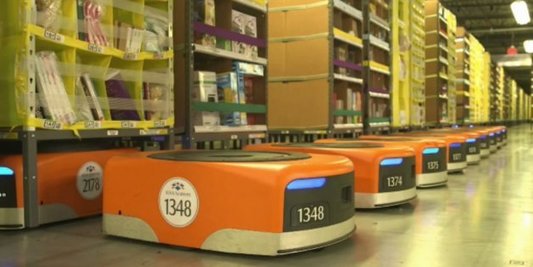News of the robots did not come as a complete surprise this week. Since its acquisition of Kiva, Amazon has made occasional remarks about its plans to incorporate robots, and The Wall Street Journal’s Greg Bensinger reported on the company’s use of robots in detail on Nov. 19. Still, Amazon has had little to say on the subject — a company representative declined to comment for Bensinger’s article — until this past Monday, when a flood of news coverage from various publications appeared just after midnight. The timing suggests that the news was “embargoed,” a term for the common media practice of agreeing not to publish certain information until a certain time.
Both MSNBC and Bloomberg did multiple TV reports from the California warehouse on Monday, providing updates on the robots — a technology that Amazon uses in only 10 of its 109 fulfillment centers worldwide, all of them in the U.S., according to the Associated Press.
All of this comes as Amazon is girding for a busy holiday shopping season. The company has disappointed investors this year, with stock down almost 17 percent over the last 12 months. On Monday, the credit rating service Moody’s lowered its outlook on Amazon from “stable” to “negative” due to the news that the company was issuing new debt.
In the press release announcing the status change, Moody’s Vice President Charlie O’Shea pointed out that Amazon faces “increased competition from brick-and-mortar retailers as they morph their successful businesses online.”
But brick-and-mortar stalwarts like Target, Walmart and The Home Depot typically don’t receive a wave of positive media attention just ahead of Black Friday and Cyber Monday.
Amazon’s strategy of offering a carefully timed peek into its notoriously secretive operations ends up getting people to focus on the company’s innovative practices, rather than any of the less flattering reasons Amazon has been in the news lately.
For instance, there’s a case currently in front of the Supreme Court about whether Amazon’s warehouse workers should be paid for the time they have to stand around waiting to be searched for stolen items after their shifts are over. And there’s Kivin Varghese, a former Amazon employee now on a hunger strike outside the company’s Seattle headquarters, demanding better working conditions in Amazon warehouses.
But people love to gawk at new technology, and by showing off its drones and robots at the start of the holiday shopping season, Amazon gets to remind people that it is as much a tech company as it is a retailer — while at the same time getting lawsuits and strikes out of the news.
It’s a pretty savvy approach. The company has 364 days to figure out what’s on tap for next year.
Sourced through Scoop.it from: www.huffingtonpost.com




Leave A Comment